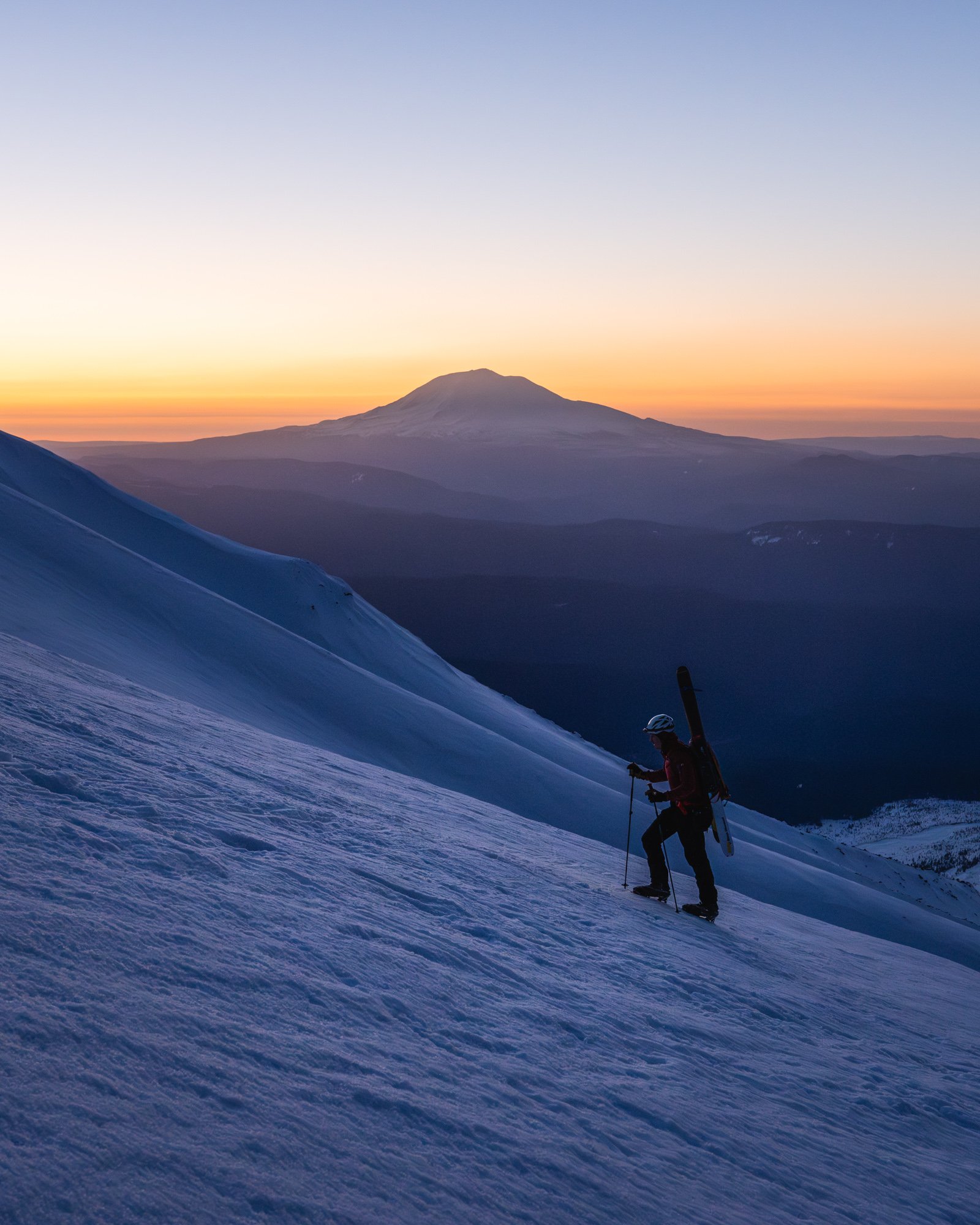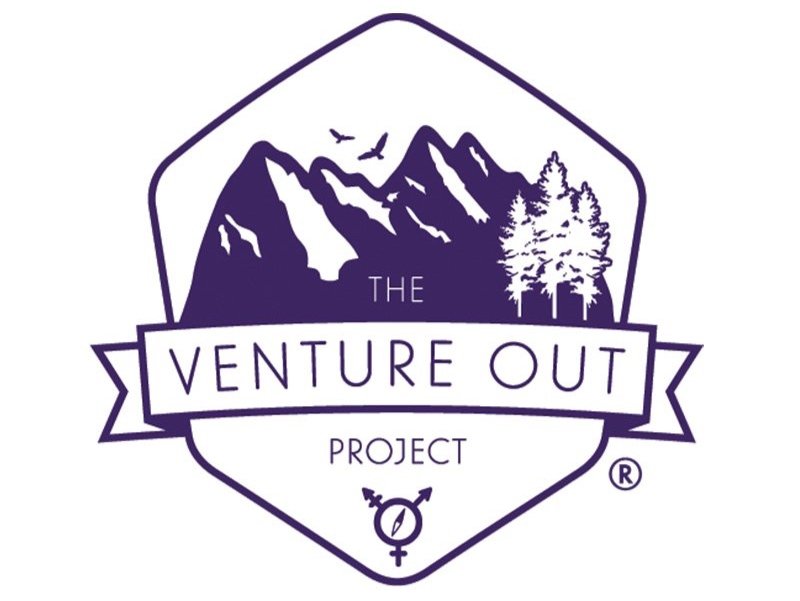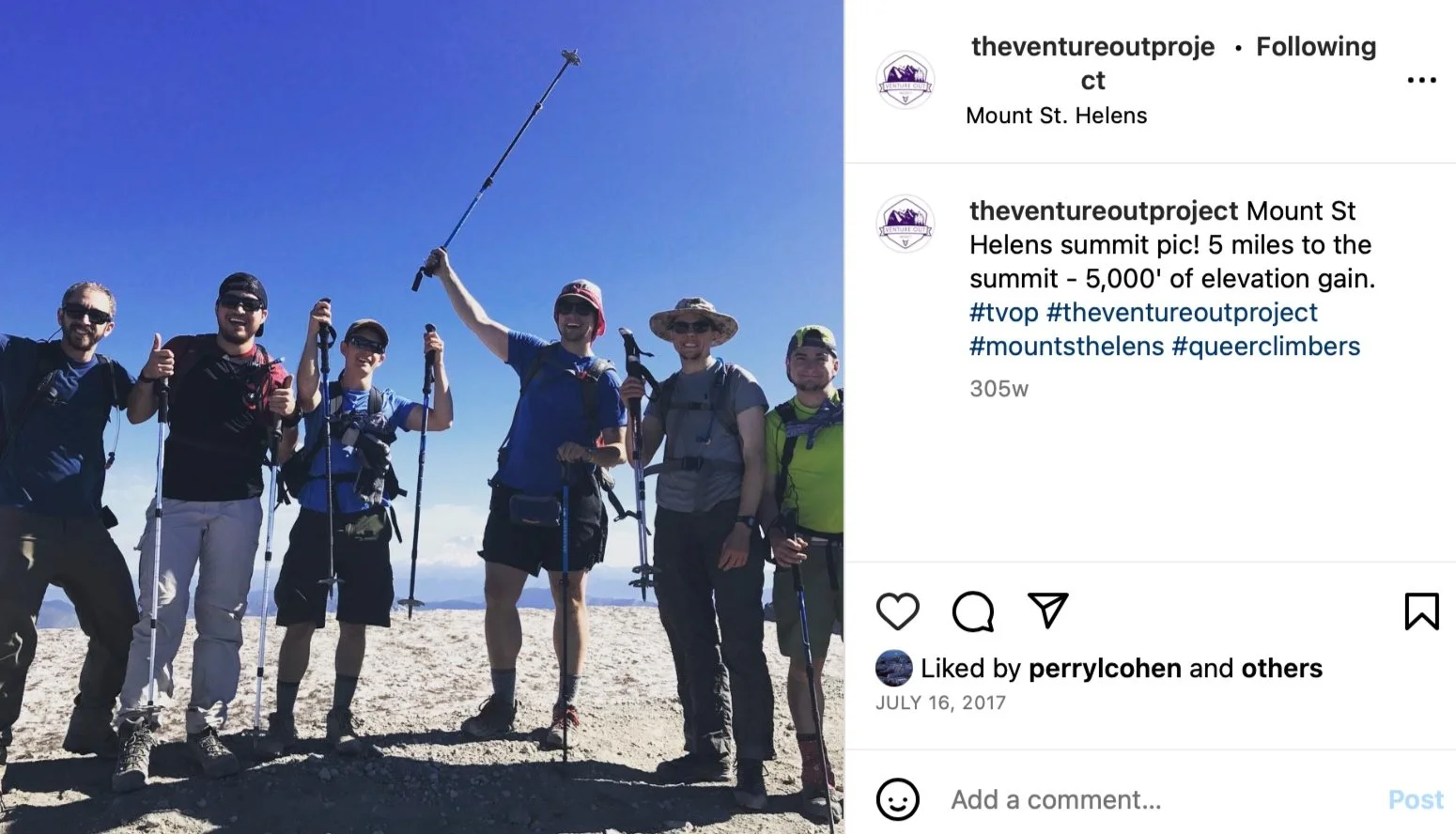Loowit (Mt. St. Helens)
WA100: Peak 1/100
written by Scott Kranz | #WA100Project
Loowit (Mount Saint Helens) is located on the traditional lands of the Cowlitz, Siletz, Klickitat, Cayuse, Umatilla and Walla Walla Peoples, past and present.
Loowit, also known as Mount Saint Helens, an active stratovolcano, as seen from the Northeast.
Halfway up Mount Saint Helens around 3 am, I found myself entirely alone except for the company of the stars and galaxies illuminating the May night sky. Between the comfortable temperatures and firm pack of the snow, I had been climbing efficiently since my 1:45 am start, skiing on the approach trail.
Within an hour of sunrise, I approached the upper mountain beneath the false summit. Although I had not intended to be, I was the first one to the upper mountain. This was a solo climb for me, but I car-camped with numerous other parties the night before at the Marble Creek trailhead, just south of Worms Flow, the standard climbing route, and I’d seen numerous parties in front of me as I approached the base of the mountain.
Rather than reaching the false summit, I did a diagonal west traverse straight to the true summit. Keenly aware of the enormous cornices hanging off the north side of the crater rim, I stepped prudently and kept plenty of distance from the edge.
Minutes before sunrise, I reached the summit proper and gazed into the volcano’s caldera center. This was my first time on this mountain, and it truly exceeded my expectations. Approaching my 10 year anniversary as a Seattleite, I made a point to visit this beautiful and unique volcano for the launch of my latest project, WA100.
Following the historic eruption in the early 1980s, Loowit, also known as Mount Saint Helens, sits prominently west of Mount Rainier and Mount Adams. Although a climb of Loowit, which is now the shortest volcano in Washington’s Cascade range, is fairly non-technical in relation to its neighboring volcanoes, it is still a strenuous climb, requiring nearly 6000 feet of elevation gain over the course of 10+ miles.
Moments after reaching the summit, the morning sun peeked above the eastern horizon and slowly lit up my surroundings. With my camera in hand, I was rapidly documenting everything I saw, with a huge smile on my face. I basked in the solitude, peace, and gratitude that comes with witnessing natural beauty in the mountains. I felt both the presence of so many others who have experienced this mountain and also those who have not had the privilege to do so. Everyone belongs in the mountains, and deserves to visit and experience a mountain and to witness a sunrise and feel the immense solitude. Standing there in the peace of the early morning, my privilege had never seemed more clear.
As I captured images of Mount Rainier to the northeast and Mount Adams to the southeast, I wondered what the world would be like if everyone was able to access and experience a similarly spectacular view, however they experience the mountains and the outdoors.
Daylight increased and I decided to work my way over to the false summit to enjoy some slightly different views. Within 10 minutes of being on the false summit, a pair of fellow climbers reached me, and they were also elated by the views. I offered to take a phone photo of them, which they accepted with big smiles. Taking a final breath from the summit rim, and drinking in one last view of the mountain’s volcanic core, I slowly made my way down. After some icy sections, I put on skis and enjoyed some fine corn skiing all the way back to the trailhead.
For able-bodied hikers, climbers, and mountaineers, both local and beyond, Loowit can be an excellent introduction to the hundred highest peaks in Washington state. While strenuous, it is a non-technical climb that requires a helmet, ice axe, and crampons, depending on snow conditions.
Though Mount St. Helens is considered a non-technical climb, the outdoor community includes a vast array of humans with all kinds of background, abilities, and levels of experience. The Venture Out Project (TVOP) is helping get us closer to a world where everyone is able to access and experience the beauty and peacefulness of nature. This nonprofit was created to “provide a safe and fun space for queer, trans, and LGBTQ+ people to experience the outdoors.” Whether you go it solo or with a group such as Venture Outdoors, please visit and experience Mount Saint Helens as you can and as you prefer. However you engage with the mountain, do so humbly, knowing we step onto these lands as visitors and, hopefully, as good stewards.
NONPROFIT SPOTLIGHT:
During this project, I will collaborate with local and national nonprofit groups to spread awareness, to fundraise, to highlight their mission and programs, and sometimes to join representatives of these groups in climbing. My nonprofits will include groups that amplify women in the outdoors; Black, Indigenous, and People of Color climbers; LGBTQ+ adventurers, and other underserved and underrepresented group members.
Venture Out Project (TVOP) helps the LGBTQ+ community develop confidence, skills, and a sense of belonging through outdoor adventure. TVOP is committed to facilitating backpacking and wilderness trips for the queer and trans community in a safe and inclusive environment. They also provide comprehensive (trans)gender inclusion workshops for organizations, educators, adventure professionals, summer camps and more.
Check out Venture Out’s summit trip and experience on this special mountain:
THE WA100 PROJECT
Over the next two seasons, Scott Kranz is embarking on a personal journey to climb and document Washington state's 100 highest peaks. These summits are all in the Cascades, the mountain range that transformed his life. His aim behind this project is to celebrate the ways in which we connect with our local landscapes while also giving back by uplifting and supporting the outdoor community and organizations that strive for inclusivity and accessibility in outdoor spaces.
ABOUT THE AUTHOR
Scott Kranz is a full-time outdoor photographer and filmmaker based in Seattle. Born and raised in Minnesota, Scott moved to Washington State in 2013 and first explored the Cascade Range, which sparked a lifelong love of outdoor adventure and photography. Since, he’s come to partner with some of the world’s leading brands and shot on all seven continents.












